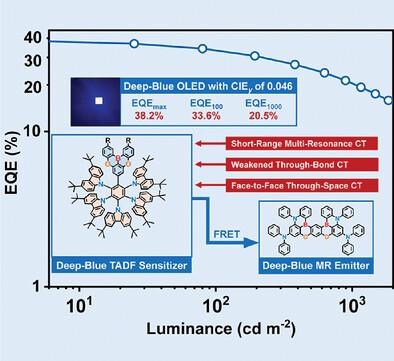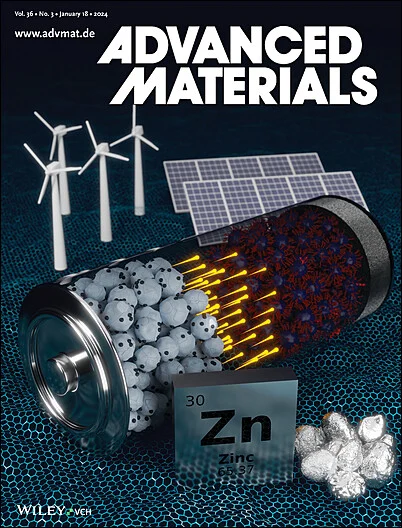Deep-Blue OLEDs with BT. 2020 Blue Gamut, External Quantum Efficiency Approaching 40%
IF 27.4
1区 材料科学
Q1 CHEMISTRY, MULTIDISCIPLINARY
引用次数: 0
Abstract
The hyperfluorescence (HF) technology holds great promise for the development of high-quality organic light-emitting diodes (OLEDs) for their excellent color purity, high efficiency, and low-efficiency roll-off. Sensitizer plays a crucial role in the performance of HF devices. However, designing sensitizers with simultaneous high photoluminescence quantum yield (PLQY), rapid radiative decay (kr), and fast reverse intersystem crossing rate (kRISC) poses a great challenge, particularly for the thermally activated delayed fluorescence (TADF) sensitizers targeting deep-blue HF device. Herein, by introducing a boron-containing multi-resonance-type acceptor into the multi-tert-butyl-carbazole encapsulated benzene molecular skeleton, two TADF emitters featuring hybridized multi-channel charge-transfer pathways, including short-range multi-resonance, weakened through-bond, and compact face-to-face through-space charge-transfer. Benefiting from the rational molecular design, the proof-of-concept sensitizers exhibit simultaneous rapid kr of 5.3 × 107 s−1, fast kRISC up to 5.9 × 105 s−1, a PQLY of near-unity, as well as ideal deep-blue emission in both solution and film. Consequently, the corresponding deep-blue HF devices not only achieve chromaticity coordinates that fully comply with the latest BT. 2020 standards, but also showcase record-high maximum external quantum efficiencies nearing 40%, along with suppressed efficiency roll-off.

求助全文
约1分钟内获得全文
求助全文
来源期刊

Advanced Materials
工程技术-材料科学:综合
CiteScore
43.00
自引率
4.10%
发文量
2182
审稿时长
2 months
期刊介绍:
Advanced Materials, one of the world's most prestigious journals and the foundation of the Advanced portfolio, is the home of choice for best-in-class materials science for more than 30 years. Following this fast-growing and interdisciplinary field, we are considering and publishing the most important discoveries on any and all materials from materials scientists, chemists, physicists, engineers as well as health and life scientists and bringing you the latest results and trends in modern materials-related research every week.
 求助内容:
求助内容: 应助结果提醒方式:
应助结果提醒方式:


